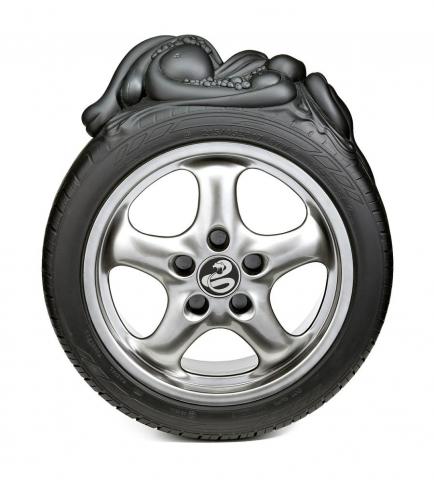RADIAL, 2005
PATRICIA PICCININI
fibreglass, automotive paint and stainless steel
70.0 x 60.0 x 21.0 cm
Roslyn Oxley9 Gallery, Sydney
Private collection, Sydney
Patricia Piccinini: Unbreaking Eggs, Roslyn Oxley9 Gallery, Sydney, 3-25 September 2005, cat. 11
Patricia Piccinini: Nature's Little Helpers, Robert Miller Gallery, New York, October - November 2005
Patricia Piccinini: In Another Life, City Gallery Wellington Te Whare Toi, New Zealand, 19 February - 11 June 2006
Patricia Piccinini: Life Cycle, Tolarno Galleries, Melbourne, 11 May - 10 June 2006
Patricia Piccinini: (tiernas) / Criaturas/ (tender) Creatures, Artium de Alava, Vitoria, Spain, October 2007 - January 2008
Hug: Recent Work by Patricia Piccinini, Des Moines Art Centre, Iowa, January - April 2007; Frye Art Museum, Seattle, 22 September 2007 - 6 January 2008
Brennan S., 'Border Patrol', in Savage, P., et al., In Another Life, City Gallery Wellington, New Zealand, 2006
Nelson, R., 'Piccinini Life Cycle', The Age, Melbourne, 17 May 2006 (illus.)
'From the Greek teraton, meaning monster, teratomas are tumorous masses containing within themselves multiple tissue types ... In a teratoma we observe not so much a fully blown creature as a mass of organic matter desperately trying to become one.'1
In Radial, 2005 Patricia Piccinini explores the advancement of science through genetic engineering and stem cell research, in addition to contemporary society's obsession with consumerism. Sculpted in the form of an alloy wheel, this work is portrayed as an icon of luxury, indicative of the automotive industry. Yet despite the fine craftsmanship of the alloy wheel, bulbous and tumour like polyps engulf the top of the tyre in the form of a teratoma. As the viewer gazes at the unnatural growth, Piccinini poses the question of existence; is it an inanimate object brought to life by biotechnology in a feat of human excellence? Or was it originally a living organism, destroyed by consumerism and absorbed into our culture, genetically modified into an everyday object? The smooth and shining rim is starkly contrasted to the abnormal protuberance, which appears to be growing and encroaching a little further each day.
Radial belongs to a group of humanised machines and objects that include cars, trucks and motor bike helmets. Where Piccinini's hybrid creatures are somewhat fleshy and abhorrent but also loveable, the machines are immaculate and glossy. Truck Babies, 1999 was exhibited alongside Radial in 2006 for Piccinini's solo exhibition, In Another Life at the City Gallery, Wellington, New Zealand. Placed within a nursery environment, the adorable miniature trucks are brought to life through pastel colours (baby blue for boys and baby pink for girls) and wide childlike 'eyes'. As people have become attached to their cars and machines, Piccinini closes the gap between the machine as an object and the machine as an important member of our family. In Another Life explores an alternate universe that is relatively close and in this genomic era of technological advancement, Piccinini raises the question: how long before her visions become realities?
Renowned for her life-like sculptures of mystical creatures that straddle the line between beast and human, Piccinini continually raises a dialogue between what is considered normal and abnormal by creating a fictional world based on an altered reality. Picinnini represented Australia at the Venice Biennale in 2003 and her works have been exhibited and collected by major galleries both internationally and in Australia.
1. Wertheim, C., and Wertheim, M., 'Teratology' in Patricia Piccinini: We Are Family, Australia Council for the Arts, Sydney, 2003, p. 26
CASSI YOUNG
